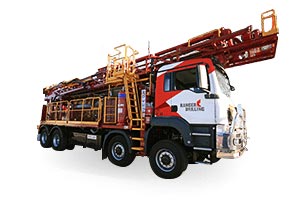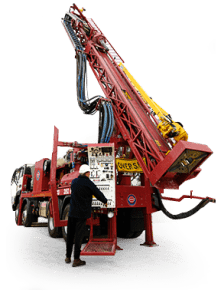Basics of Reverse Circulation (RC) Drilling – What is RC Drilling?
Reverse Circulation, or RC, drilling uses drill rods with inner and outer tubes & is sometimes referred to as Dual wall or Dual Tube Drilling. Reverse circulation is achieved by blowing air down the annulus of the rod, the differential pressure creating air lift of the water and cuttings up the inner tube via which the drill cuttings are returned to the surface and on through the sampling system.

RC Drilling with RC Hammer
The drilling mechanism is a pneumatic reciprocating piston known as a hammer driving a tungsten-steel drill bit. The most commonly used sizes for RC Hammer are 4” and 4½” inches. RC Hammers have round metal ‘buttons’ that protrude from the bit, which are required to drill through rock and shale.
Modern RC drilling utilizes much larger rigs and depths of up to 500 meters are routinely achieved. RC drilling ideally produces dry rock chips, as large air compressors dry the rock out ahead of the advancing drill bit.

Cost Advantages of RC Drilling
An RC drilling program is faster and more cost-effective than diamond coring. However, it’s the quality of the samples that is the most important consideration. Geologists must have confidence in the accuracy of the sample and way that up against the time and cost involved.
When that is done it’s easy to see why RC Drilling, with its recent technological advances, has become the preferred drilling method for exploration and in-pit grade control.
RC Drilling for Grade Control
Reverse Circulation is the preferred drilling method for grade control in open pit mining operations because it is fast and cost-effective. Grade control is used to define the ore grades and ore blocks in the pit and also provide knowledge for mine planning and blasting.
This information is critical to reduce waste rock (dilution) in concentrator feed as dilution can vary from 5-40%. RC grade control is the most cost-effective and accurate way to define boundaries between waste rock and ore bodies, making it an important value add to any ore reserve.
In recent years we’ve even seen the drilling industry adopt RC drilling for underground operations.




 Youtube
Youtube LinkedIn
LinkedIn Facebook
Facebook Instagram
Instagram